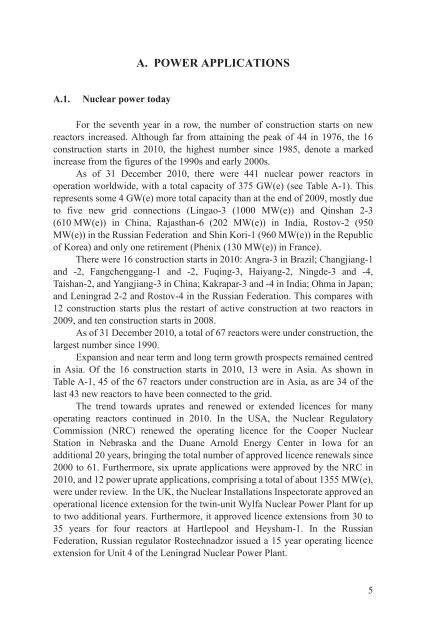Nuclear Technology Review 2011 - IAEA
Nuclear Technology Review 2011 - IAEA
Nuclear Technology Review 2011 - IAEA
You also want an ePaper? Increase the reach of your titles
YUMPU automatically turns print PDFs into web optimized ePapers that Google loves.
A.1. <strong>Nuclear</strong> power today<br />
A. POWER APPLICATIONS<br />
For the seventh year in a row, the number of construction starts on new<br />
reactors increased. Although far from attaining the peak of 44 in 1976, the 16<br />
construction starts in 2010, the highest number since 1985, denote a marked<br />
increase from the figures of the 1990s and early 2000s.<br />
As of 31 December 2010, there were 441 nuclear power reactors in<br />
operation worldwide, with a total capacity of 375 GW(e) (see Table A-1). This<br />
represents some 4 GW(e) more total capacity than at the end of 2009, mostly due<br />
to five new grid connections (Lingao-3 (1000 MW(e)) and Qinshan 2-3<br />
(610 MW(e)) in China, Rajasthan-6 (202 MW(e)) in India, Rostov-2 (950<br />
MW(e)) in the Russian Federation and Shin Kori-1 (960 MW(e)) in the Republic<br />
of Korea) and only one retirement (Phenix (130 MW(e)) in France).<br />
There were 16 construction starts in 2010: Angra-3 in Brazil; Changjiang-1<br />
and -2, Fangchenggang-1 and -2, Fuqing-3, Haiyang-2, Ningde-3 and -4,<br />
Taishan-2, and Yangjiang-3 in China; Kakrapar-3 and -4 in India; Ohma in Japan;<br />
and Leningrad 2-2 and Rostov-4 in the Russian Federation. This compares with<br />
12 construction starts plus the restart of active construction at two reactors in<br />
2009, and ten construction starts in 2008.<br />
As of 31 December 2010, a total of 67 reactors were under construction, the<br />
largest number since 1990.<br />
Expansion and near term and long term growth prospects remained centred<br />
in Asia. Of the 16 construction starts in 2010, 13 were in Asia. As shown in<br />
Table A-1, 45 of the 67 reactors under construction are in Asia, as are 34 of the<br />
last 43 new reactors to have been connected to the grid.<br />
The trend towards uprates and renewed or extended licences for many<br />
operating reactors continued in 2010. In the USA, the <strong>Nuclear</strong> Regulatory<br />
Commission (NRC) renewed the operating licence for the Cooper <strong>Nuclear</strong><br />
Station in Nebraska and the Duane Arnold Energy Center in Iowa for an<br />
additional 20 years, bringing the total number of approved licence renewals since<br />
2000 to 61. Furthermore, six uprate applications were approved by the NRC in<br />
2010, and 12 power uprate applications, comprising a total of about 1355 MW(e),<br />
were under review. In the UK, the <strong>Nuclear</strong> Installations Inspectorate approved an<br />
operational licence extension for the twin-unit Wylfa <strong>Nuclear</strong> Power Plant for up<br />
to two additional years. Furthermore, it approved licence extensions from 30 to<br />
35 years for four reactors at Hartlepool and Heysham-1. In the Russian<br />
Federation, Russian regulator Rostechnadzor issued a 15 year operating licence<br />
extension for Unit 4 of the Leningrad <strong>Nuclear</strong> Power Plant.<br />
5

















